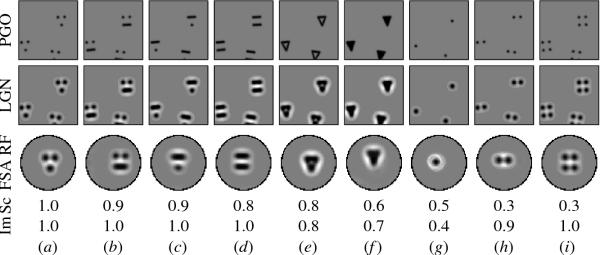
Click on the image to see a PDF version (for zooming in)
Fig. 10.11. Effect of training patterns on face preferences.
Results are shown for nine matched face detection simulations
(bypassing V1), each with a different set of input patterns. The top
row displays examples of these patterns, drawn on the retina. The
second row shows the LGN response to the retinal input, which forms
the input to the FSA in these simulations. The third row plots a
sample FSA receptive field after self-organization, visualized by
subtracting the OFF weights from the ON; other neurons learned similar
RFs. In each case the HLISSOM network learns FSA RFs similar to the
LGN representation. These RFs are not patchy, because they no longer
represent the patchy V1 activities. The two numerical rows quantify
the face selectivity of each network. The row labeled "Sc" specifies
the selectivity for facelike schematics (from Figure 10.6b-d) relative
to non-facelike schematics (from Figure 10.6e-i). The row labeled "Im"
lists the selectivity for the six face images from Figure 10.13
relative to the six comparable object images in the same figure. The
different training patterns gave rise to different
selectivities. Pattern (g) leads to equal responses for both facelike
and non-facelike schematics (selectivity of 0.5), and (h) and (i) have
a greater overall response to the non-facelike schematics (selectivity
lower than 0.5). Thus, not all training patterns can explain
preferences for schematic faces even if they match some parts of the
face. Similarly, the single-dot pattern (g) has a selectivity below
0.5 for real faces, indicating a stronger response for the objects
than for real faces. The other training patterns all have the same
size as real faces, or match at least two parts of the face, and thus
have selectivities larger than 0.5 for real faces. Overall, the shape
of the training pattern is clearly important for face selectivity,
both for schematics and real faces, but it need not be controlled very
tightly to result in face-selective responses.
|